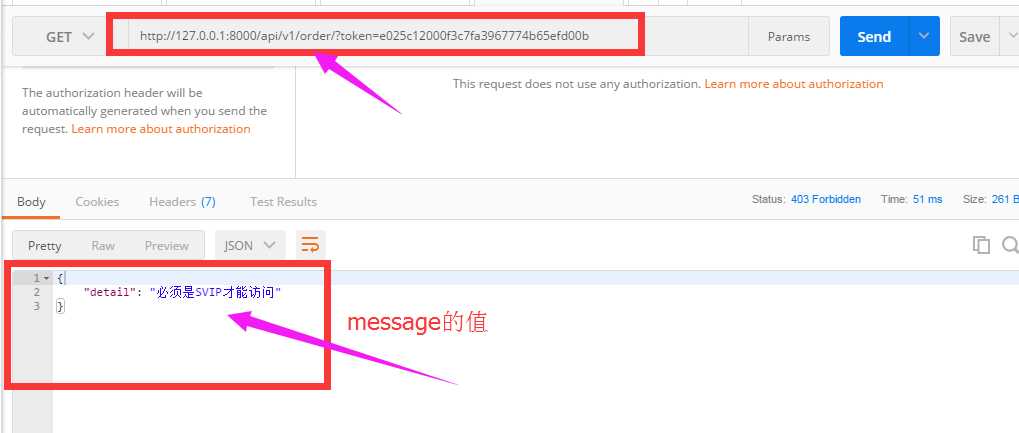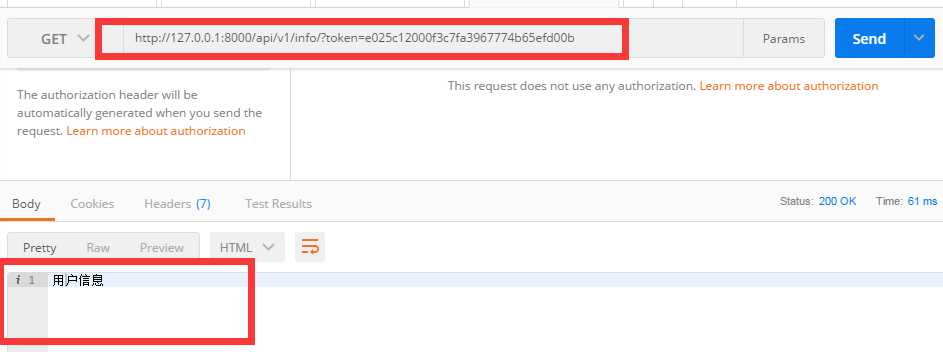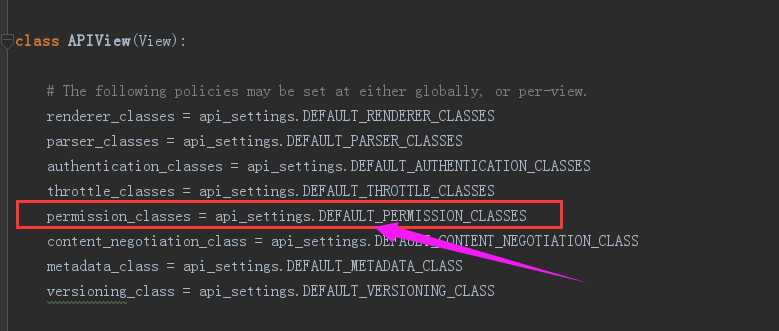标签:odi mes framework anything pat highlight imp mod 通用
-写一个类: class MyPer(BasePermission): message=‘您没有权限‘ def has_permission(self, request, view): # 取出当前登录用户 user = request.user # 取出当前登录用户类型的中文 tt = user.get_user_type_display() if user.user_type == 0: return True else: return False -局部使用 permission_classes=[MyPer] -全局使用 在setting中 "DEFAULT_PERMISSION_CLASSES":[‘app01.auth.MyPer‘],
(1)API/utils文件夹下新建premission.py文件,代码如下:
# utils/permission.py
class SVIPPremission(object):
message = "必须是SVIP才能访问"
def has_permission(self,request,view):
if request.user.user_type != 3:
return False
return True
class MyPremission(object):
def has_permission(self,request,view):
if request.user.user_type == 3:
return False
return True
(2)settings.py全局配置权限
#全局
REST_FRAMEWORK = {
"DEFAULT_AUTHENTICATION_CLASSES":[‘API.utils.auth.Authentication‘,],
"DEFAULT_PERMISSION_CLASSES":[‘API.utils.permission.SVIPPremission‘],
}
(3)views.py添加权限
from django.shortcuts import render,HttpResponse
from django.http import JsonResponse
from rest_framework.views import APIView
from API import models
from rest_framework.request import Request
from rest_framework import exceptions
from rest_framework.authentication import BaseAuthentication
from API.utils.permission import SVIPPremission,MyPremission
ORDER_DICT = {
1:{
‘name‘:‘apple‘,
‘price‘:15
},
2:{
‘name‘:‘dog‘,
‘price‘:100
}
}
def md5(user):
import hashlib
import time
#当前时间,相当于生成一个随机的字符串
ctime = str(time.time())
m = hashlib.md5(bytes(user,encoding=‘utf-8‘))
m.update(bytes(ctime,encoding=‘utf-8‘))
return m.hexdigest()
class AuthView(APIView):
‘‘‘用于用户登录验证‘‘‘
authentication_classes = [] #里面为空,代表不需要认证
permission_classes = [] #不里面为空,代表不需要权限
def post(self,request,*args,**kwargs):
ret = {‘code‘:1000,‘msg‘:None}
try:
user = request._request.POST.get(‘username‘)
pwd = request._request.POST.get(‘password‘)
obj = models.UserInfo.objects.filter(username=user,password=pwd).first()
if not obj:
ret[‘code‘] = 1001
ret[‘msg‘] = ‘用户名或密码错误‘
#为用户创建token
token = md5(user)
#存在就更新,不存在就创建
models.UserToken.objects.update_or_create(user=obj,defaults={‘token‘:token})
ret[‘token‘] = token
except Exception as e:
ret[‘code‘] = 1002
ret[‘msg‘] = ‘请求异常‘
return JsonResponse(ret)
class OrderView(APIView):
‘‘‘
订单相关业务(只有SVIP用户才能看)
‘‘‘
def get(self,request,*args,**kwargs):
self.dispatch
#request.user
#request.auth
ret = {‘code‘:1000,‘msg‘:None,‘data‘:None}
try:
ret[‘data‘] = ORDER_DICT
except Exception as e:
pass
return JsonResponse(ret)
class UserInfoView(APIView):
‘‘‘
订单相关业务(普通用户和VIP用户可以看)
‘‘‘
permission_classes = [MyPremission,] #不用全局的权限配置的话,这里就要写自己的局部权限
def get(self,request,*args,**kwargs):
print(request.user)
return HttpResponse(‘用户信息‘)
urls.py
from django.contrib import admin
from django.urls import path
from API.views import AuthView,OrderView,UserInfoView
urlpatterns = [
path(‘admin/‘, admin.site.urls),
path(‘api/v1/auth/‘,AuthView.as_view()),
path(‘api/v1/order/‘,OrderView.as_view()),
path(‘api/v1/info/‘,UserInfoView.as_view()),
]
auth.py
# API/utils/auth/py
from rest_framework import exceptions
from API import models
from rest_framework.authentication import BaseAuthentication
class Authentication(BaseAuthentication):
‘‘‘用于用户登录验证‘‘‘
def authenticate(self,request):
token = request._request.GET.get(‘token‘)
token_obj = models.UserToken.objects.filter(token=token).first()
if not token_obj:
raise exceptions.AuthenticationFailed(‘用户认证失败‘)
#在rest framework内部会将这两个字段赋值给request,以供后续操作使用
return (token_obj.user,token_obj)
def authenticate_header(self, request):
pass
(4)测试
普通用户访问OrderView,提示没有权限

普通用户访问UserInfoView,可以返回信息

(1)dispatch
def dispatch(self, request, *args, **kwargs): """ `.dispatch()` is pretty much the same as Django‘s regular dispatch, but with extra hooks for startup, finalize, and exception handling. """ self.args = args self.kwargs = kwargs #对原始request进行加工,丰富了一些功能 #Request( # request, # parsers=self.get_parsers(), # authenticators=self.get_authenticators(), # negotiator=self.get_content_negotiator(), # parser_context=parser_context # ) #request(原始request,[BasicAuthentications对象,]) #获取原生request,request._request #获取认证类的对象,request.authticators #1.封装request request = self.initialize_request(request, *args, **kwargs) self.request = request self.headers = self.default_response_headers # deprecate? try: #2.认证 self.initial(request, *args, **kwargs) # Get the appropriate handler method if request.method.lower() in self.http_method_names: handler = getattr(self, request.method.lower(), self.http_method_not_allowed) else: handler = self.http_method_not_allowed response = handler(request, *args, **kwargs) except Exception as exc: response = self.handle_exception(exc) self.response = self.finalize_response(request, response, *args, **kwargs) return self.response
(2)initial
def initial(self, request, *args, **kwargs): """ Runs anything that needs to occur prior to calling the method handler. """ self.format_kwarg = self.get_format_suffix(**kwargs) # Perform content negotiation and store the accepted info on the request neg = self.perform_content_negotiation(request) request.accepted_renderer, request.accepted_media_type = neg # Determine the API version, if versioning is in use. version, scheme = self.determine_version(request, *args, **kwargs) request.version, request.versioning_scheme = version, scheme # Ensure that the incoming request is permitted #4.实现认证 self.perform_authentication(request) #5.权限判断 self.check_permissions(request) self.check_throttles(request)
(3)check_permissions
里面有个has_permission这个就是我们自己写的权限判断
def check_permissions(self, request): """ Check if the request should be permitted. Raises an appropriate exception if the request is not permitted. """ #[权限类的对象列表] for permission in self.get_permissions(): if not permission.has_permission(request, self): self.permission_denied( request, message=getattr(permission, ‘message‘, None) )
(4)get_permissions
def get_permissions(self):
"""
Instantiates and returns the list of permissions that this view requires.
"""
return [permission() for permission in self.permission_classes]
(5)permission_classes

所以settings全局配置就如下
#全局
REST_FRAMEWORK = {
"DEFAULT_PERMISSION_CLASSES":[‘API.utils.permission.SVIPPremission‘],
}
django-rest-framework内置权限BasePermission
默认是没有限制权限
class BasePermission(object):
"""
A base class from which all permission classes should inherit.
"""
def has_permission(self, request, view):
"""
Return `True` if permission is granted, `False` otherwise.
"""
return True
def has_object_permission(self, request, view, obj):
"""
Return `True` if permission is granted, `False` otherwise.
"""
return True
我们自己写的权限类,应该去继承BasePermission,修改之前写的permission.py文件
# utils/permission.py
from rest_framework.permissions import BasePermission
class SVIPPremission(BasePermission):
message = "必须是SVIP才能访问"
def has_permission(self,request,view):
if request.user.user_type != 3:
return False
return True
class MyPremission(BasePermission):
def has_permission(self,request,view):
if request.user.user_type == 3:
return False
return True
总结:
(1)使用
(2)返回值
(3)局部
(4)全局
REST_FRAMEWORK = {
#权限
"DEFAULT_PERMISSION_CLASSES":[‘API.utils.permission.SVIPPremission‘],
}
标签:odi mes framework anything pat highlight imp mod 通用
原文地址:https://www.cnblogs.com/596014054-yangdongsheng/p/10402986.html